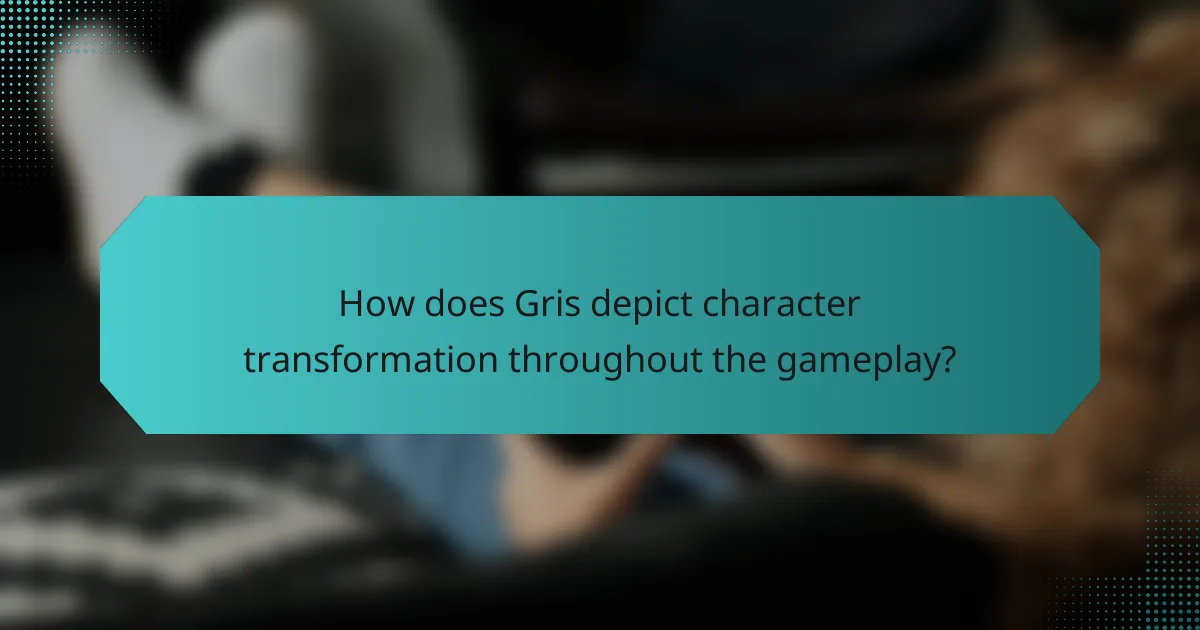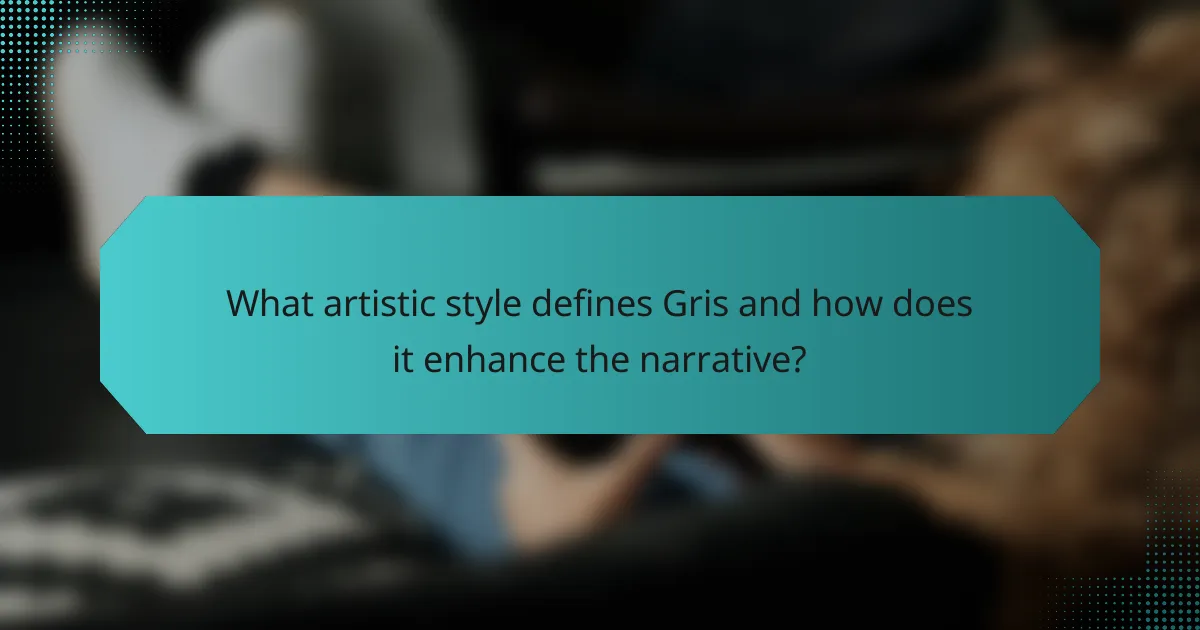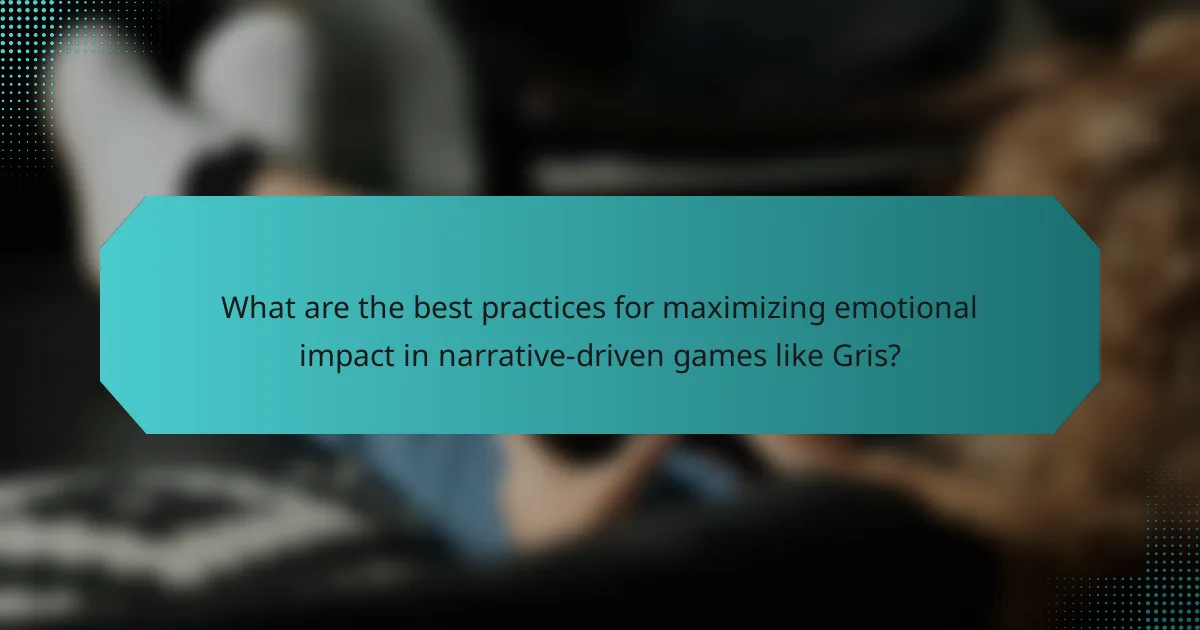Gris offers a profound exploration of character transformation and emotional journeys through its unique artistic style. The game utilises a watercolour aesthetic to enhance narrative depth and emotional resonance. Each level symbolises distinct emotional states, guiding players through themes of loss and recovery. This integration of visual storytelling and gameplay mechanics enriches the overall experience, making Gris a standout in the indie gaming landscape.

How does Gris depict character transformation throughout the gameplay?
Gris effectively depicts character transformation through visual storytelling and emotional progression. The protagonist’s journey reflects stages of grief, represented by distinct colours and environments. Each level symbolises a unique emotional state, enhancing player connection. The artistic style complements this transformation, using minimalistic design to evoke feelings. As the gameplay progresses, the character evolves, illustrating resilience and hope. This transformation is both a narrative device and a gameplay mechanic, enriching the overall experience.
What stages of emotional growth are represented in Gris?
Gris represents four stages of emotional growth: sadness, anger, acceptance, and joy. Each stage reflects a distinct emotional experience through visual and gameplay elements. The character’s transformation symbolises the journey from despair to hope, enhancing the narrative depth. The artistic style reinforces these emotions, using colour and form to evoke the player’s feelings.
How do gameplay mechanics reflect character evolution?
Gameplay mechanics in “Gris” reflect character evolution through emotional transitions and artistic style changes. As players progress, the mechanics shift to convey despair, hope, and growth. For instance, the introduction of new abilities aligns with Gris’s emotional state, showcasing her journey through vibrant visual transformations. This unique integration of gameplay and narrative deepens the player’s connection to the character, enhancing the overall experience. The mechanics serve not only as challenges but also as a means of storytelling, illustrating how gameplay can mirror personal evolution.
Which visual elements symbolise transformation in Gris?
Visual elements that symbolise transformation in Gris include the use of colour shifts, evolving landscapes, and character design changes. These elements illustrate the protagonist’s emotional journey through stages of grief. The transition from monochrome to vibrant colours signifies hope and renewal. The fluidity of the environments reflects the character’s inner growth, making transformation a central theme.

What artistic style defines Gris and how does it enhance the narrative?
Gris is defined by its watercolour aesthetic, which enhances the narrative through emotional resonance. The fluidity of the art style mirrors the character’s internal journey, illustrating transformation and growth. Each colour palette reflects distinct emotional states, guiding players through themes of loss and recovery. This unique attribute of colour symbolism deepens the player’s connection to the character’s experiences, making the narrative more impactful.
How do colour palettes contribute to the storytelling in Gris?
Colour palettes significantly enhance storytelling in Gris by visually representing emotional states and character transformations. Each colour conveys specific feelings, guiding players through the protagonist’s journey. For instance, warm hues symbolise hope and growth, while cooler tones reflect despair and loss. This dynamic use of colour not only enriches the narrative but also deepens player engagement, making emotional experiences more impactful. The strategic shifts in colour throughout the game correspond with pivotal moments, illustrating the character’s evolution and resonating with the audience’s emotions.
What role does animation play in conveying emotions in Gris?
Animation in Gris effectively conveys emotions through its vibrant colour palette, fluid movement, and artistic style. These elements enhance the character transformation and emotional journey, allowing players to connect deeply with the narrative. The use of colour shifts symbolises emotional states, while the graceful animations reflect the protagonist’s inner turmoil and growth. As a result, animation serves as a powerful medium for storytelling, evoking empathy and engagement throughout the gameplay experience.
How do influences from other art forms shape the aesthetic of Gris?
Influences from other art forms significantly shape the aesthetic of Gris. The game draws inspiration from various mediums, including painting, animation, and music, to create a cohesive emotional journey.
The visual style of Gris mirrors elements of watercolour painting, characterised by soft colours and fluid transitions. This artistic choice enhances the game’s exploration of themes like loss and recovery. Additionally, the influence of animation techniques allows for dynamic character transformations that reflect emotional states, reinforcing the narrative depth.
Music plays a crucial role in Gris, with its score designed to evoke specific feelings. The synergy between visuals and sound creates an immersive experience, guiding players through the protagonist’s emotional landscape. This integration of different art forms results in a unique aesthetic that resonates deeply with players.

Why is the emotional journey central to the experience of playing Gris?
The emotional journey is central to playing Gris because it encapsulates themes of loss, acceptance, and transformation. Players navigate through distinct emotional landscapes represented by colours and artistic visuals. Each stage of the game corresponds to a specific emotional state, enhancing the player’s connection to the character’s development. The unique attribute of Gris lies in its ability to convey complex emotions without dialogue, relying solely on visual storytelling and music. This immersive experience fosters a deep emotional resonance, making the journey not just a gameplay mechanic but a profound exploration of human emotion.
What themes of loss and recovery are explored in the narrative?
The narrative of “Gris” explores themes of loss and recovery through the protagonist’s emotional journey. The character undergoes profound transformation as she navigates grief and finds healing. Each artistic style reflects different emotional states, illustrating the impact of loss on personal identity. The journey emphasises resilience, showing how acceptance leads to recovery and self-discovery.
How does player interaction influence emotional engagement in Gris?
Player interaction significantly enhances emotional engagement in Gris by creating a deeper connection to the character’s journey. As players navigate the beautifully crafted world, their actions influence the character’s transformation and emotional state. This dynamic fosters empathy and investment in the narrative, amplifying the overall experience. The game’s artistic style, combined with player choices, uniquely tailors emotional responses, making each interaction impactful. Such engagement is rare in gaming, as it intertwines visual aesthetics with personal involvement, enriching the player’s emotional journey.
What impact does the soundtrack have on the emotional landscape of the game?
The soundtrack profoundly shapes the emotional landscape of “Gris” by enhancing the narrative and character transformation. The music complements the game’s artistic style, creating an immersive experience that evokes feelings of joy, sadness, and introspection. Each musical piece aligns with specific gameplay moments, reinforcing the player’s emotional journey. The unique attribute of the soundtrack is its ability to adapt dynamically, mirroring the protagonist’s inner struggles and growth throughout the game. This synergy between sound and visuals deepens player engagement and emotional resonance.

Which unique attributes set Gris apart from other indie games?
Gris stands out from other indie games due to its unique artistic style, character transformation mechanics, and profound emotional journey. The game employs a watercolour aesthetic that enhances its narrative depth. Character transformation symbolises personal growth, allowing players to experience emotional stages visually and interactively. This integration of art and gameplay creates a distinctive atmosphere, setting Gris apart in the indie gaming landscape.
How does Gris challenge traditional game mechanics to tell its story?
Gris challenges traditional game mechanics by prioritising emotional storytelling over conventional gameplay. The game employs a minimalist approach, using colour and visual metaphors to represent the protagonist’s emotional journey. This transformation is not driven by traditional objectives but by the exploration of feelings, allowing players to experience growth through artistic expression. Unique attributes, such as the seamless integration of platforming with narrative, enhance player immersion and redefine engagement in gaming.
What makes the visual storytelling in Gris distinctive?
The visual storytelling in Gris is distinctive due to its seamless integration of art and emotion. The game’s artistic style employs a watercolour palette and fluid animations, enhancing character transformation. Each scene reflects a unique emotional state, guiding players through a profound journey of grief and healing. This approach creates an immersive experience where visuals and narrative coalesce, making the emotional journey resonate deeply with players.

What are the best practices for maximizing emotional impact in narrative-driven games like Gris?
To maximize emotional impact in narrative-driven games like Gris, focus on character development, artistic expression, and immersive storytelling.
Character transformation is key; players connect deeply with characters who undergo significant growth. Gris effectively uses colour and visual symbolism to represent emotional states, enhancing the player’s experience.
Artistic style plays a vital role; the game’s watercolour aesthetics evoke feelings of nostalgia and introspection, reinforcing the emotional journey.
Lastly, crafting a compelling narrative that resonates with universal themes, such as loss and hope, ensures players feel invested in the story. This combination of elements creates a rich emotional tapestry that enhances player engagement.